These yeasted gluten-free donuts are fried to crisp golden perfection, with a soft and fluffy center. No more missing out, now you can make a gluten-free version of that signature donut shop glazed donut easily at home! This recipe works as a weekend project or a quick make-ahead dough that rises overnight in the fridge.
This post is sponsored by Bob’s Red Mill, a long-term partner of Snixy Kitchen
My kids have no idea how good they've got it in the treat department. I have been tweaking and testing this gluten-free fried donut recipe for months. There have been daily trays of freshly fried donuts churning out of our kitchen. My kids think it's totally normal to get customized sprinkle donuts as a regular afternoon treat.
Meanwhile, my neighbors think I've opened a donut shop. After all the tests, I'm convinced these gluten-free fried donuts are *chef's kiss* the best gluten-free donuts.
Homemade Gluten-Free Donuts
I'm very particular about my donuts. They must be yeasted, they must be fried, with a crisp golden brown shell that gives way to a soft and fluffy center that melts in your mouth. And for that reason, I've mostly avoided gluten-free donuts up until now.
Donut lovers rejoice - finally, a gluten-free fried donut that doesn't taste like dense cardboard! Quite the opposite. this donut recipe checks all the boxes - crisp, fluffy, light, and chewy.
I've fried up these crisp and fluffy donuts as my fifth recipe in a year-long partnership with Bob’s Red Mill. Here’s a list of all the recipes I’ve made in partnership with Bob’s Red Mill over the years.
I've also developed a seasonally appropriate pumpkin version of these gluten-free donuts, so stay tuned for that recipe soon!
Are Donuts Gluten-Free?
Most donuts are not gluten-free, sadly. Donut shop-style yeasted donuts are one of the few things I've missed after going gluten-free. Until now, that is.
You can now easily fry your own fluffy and chewy yeasted donuts with this gluten-free donut recipe.
Difference between a cake donut and a yeast donut
Three are two main types of donuts - cake donuts and yeast donuts. Cake donuts are basically what they sound like - sweetened cake batter leavened with baking powder. At a donut shop, cake donuts are extruded and fried, but at home, many cake donut recipes call for baking in a donut tin.
One subcategory of cake donuts receives a special mention: mochi cake donuts, which I might argue belongs in its own third category.
Yeast donuts are raised with yeast - think a classic glazed donut. This is what Krispy Kreme donuts are. The dough is lightly sweetened, cut into a donut shape, and deep-fried. They're airier in texture than cake donuts and have a slight yeast flavor. Most of their sweetening comes from the glaze.
Most gluten-free donut recipes I've found on the internet are baked cake donuts, which, in my opinion, just taste like cake with icing. I'd rather just have cake, more of the fluffy inside with less of the dry crust that a donut pan creates. If I'm eating a donut, gimme that crispy fried kind.
The Best gluten-free donuts
The donuts you see here are gluten-free yeast donuts, deep-fried to crisp golden perfection, with a fluffy and chewy center.
Yeasted gluten-free recipes need a little help to encourage and trap more air bubbles. In this case, I've added some baking powder for support, making them almost a cross between a fried yeast donut and a fried cake donut.
What Flour to use for Gluten-Free Donuts?
I used different Bob's Red Mill flours to test multiple flour blends, conducting taste tests with over a dozen friends and neighbors. The verdict was split between the oat flour and almond flour variations so I am sharing both of the winners.
The differences between the two variations are so subtle that I mixed them up on the plate and had trouble distinguishing which was which. I love both versions for different reasons and can't choose a favorite. Whichever you choose, you'll be happy.
For all of these flours, I only use Bob's Red Mill brand flours, which I find are consistent in quality and the most finely ground to produce the best texture. The most common reason I find for someone's recipe not turning out is that they subbed in a different brand of flour. To avoid disappointment, reach for Bob's Red Mill.
Oat flour variation
The gluten-free oat flour variation rises a bit more and fries up slightly more airy and light. The gluten-free oat flour variation uses gluten-free oat flour, millet flour, sweet rice flour, and tapioca flour.
Gluten-Free Oat Flour gives lightness and structure, with its warm and wholesome flavor coming through and pairing well with the fried glazed donut.
- Sub in by weight: If you don't have oat flour, you can make your own by grinding gluten-free rolled oats in a blender or food processor until fine, then sifting out any larger pieces. Alternatively, if you cannot tolerate oats, I would recommend the almond flour variation below. And if you cannot tolerate either oats or nuts, my next best recommendation would be to use the oat flour version, subbing out the oat flour by weight with Bob's Red Mill 1-to-1 flour.
Millet Flour is a neutral flour in texture and flavor that’s used almost as the mediator between the oat and sweet rice flour.
- Sub in by weight: sorghum flour, brown or white rice flour, or Bob's Red Mill 1-to-1 flour.
Sweet Rice Flour, made from sticky rice, is distinctively different than white rice or brown rice flour, and despite its name, it's not sweet. Sweet rice flour is the same flour used to make mochi, and as such, its stickiness helps to bind doughs together. In these donuts, it adds chewiness like a classic glazed donut.
- Substitution: In general, I don't recommend substituting sweet rice flour as I find it's essential. You can try subbing in Bob's Red Mill 1-to-1 flour or Tapioca Flour by weight, but your results will vary.
Tapioca flour adds chewiness and helps mimic the fluffiness of a classic yeast donut. It adds just a bit more softness and loftiness to the rise.
- Sub in by weight: arrowroot starch, potato starch, or Bob's Red Mill 1-to-1 flour.
Almond flour variation
The almond flour version is a bit chewier, but not quite as lofty. The flavor is more reminiscent of that signature bakery-shop fried glazed donut.
Superfine Blanched Almond Flour has a mildly sweet flavor that, in baked goods - or this case fried goods - tastes very similar to a classic gluten-filled treat. The result does not taste like almonds, but the subtle nuttiness is perfect for a dough that's only lightly sweetened.
- Substitution: If you cannot tolerate nuts, I would recommend using the oat flour version of the donuts. I would not suggest trying to substitute with a different nut flour as this almond flour donut relies on the subtle neutral flavor and moisture level that is unique to almond flour.
Tapioca flour adds chewiness and helps mimic the fluffiness of a classic yeast donut. It adds just a bit more softness and loftiness to the rise. In the almond flour variation, tapioca flour is essential. Without it, the donuts will be dense and not chewy.
- Sub in by weight: arrowroot starch, potato starch, or Bob's Red Mill 1-to-1 flour.
Brown Rice Flour, like millet flour, is a neutral flour in texture and flavor, acting as the mediator between almond flour and tapioca flour.
- Sub in by weight: millet flour or Bob's Red Mill 1-to-1 flour.
Corn starch helps the outside of the donuts crisp up like a classic donut.
- Sub in by weight: additional tapioca flour.
How to Make Gluten-Free Donuts
Here are the steps to making fluffy gluten-free Krispy Kreme copycat donuts at home.
- Make the dough. I recommend a stand mixer to make this yeasted dough, but you can also use a hand mixer. The dough will be very sticky, so kneading it by hand would be a big mess. After you mix the dough, cover the surface with tapioca flour. Dust your work surface well with tapioca flour before dumping the dough onto the surface. Sprinkle more tapioca flour on top and ensure your hands are coated in tapioca flour before touching the dough. This dough is much softer and sticker than gluten dough. Toss the dough until the entire surface is covered with tapioca flour and it is no longer sticky.
- Let the dough rise. Transfer the dough to an oiled glass bowl. Cover and let rise for 2 hours, until doubled in size.
- Cut out your donuts: Press the dough into ½ - ¾ inch thickness and cut out your donuts and/or donut holes, transferring your donuts to a parchment-lined pan. Any size works - I use 3 to 3.5-inch cutters. Knead the scraps into a ball and repeat.
- Let the dough rise again. Cover and let rise for 1 hour.
- Prepare the glaze. Whisk together the glaze ingredients.
- Fry the donuts. Heat 2-3 inches of oil to 360°F - this is a bit cooler than normal frying temperature because the gluten-free dough needs to cook just a little longer and you don't want the outside to get too dark in the process. Fry 3-4 donuts at a time, 2 minutes on each side, until golden brown. Transfer to a wire rack over a baking sheet to cool slightly for 3-5 minutes. Repeat.
- Glaze the donuts. When you finish frying the next batch, dunk the slightly cooled donuts into the glaze on both sides. Place back on the wire rack. The glaze will set after about 20 minutes.
Enjoy your homemade gluten-free donuts!
Active Dry Yeast versus Instant Yeast
I tested these gluten-free donuts with both active dry yeast and instant yeast. Both will work, however, I noticed that the instant yeast donuts were not quite as fluffy as the active dry yeast donuts.
If all you have is instant yeast, replace it 1:1. You do not need to activate it in the warm milk, so just add it to the dry ingredients. Continue with the rest of the recipe as written, including warming the milk. You may also find your dough rises a bit quicker with instant yeast.
Can you make donuts ahead of time?
Yes - prep the donuts and let them rise overnight in the fridge! If you want donuts for breakfast, a 2-hour rise coupled with a 1-hour rise is not economical with your time. Letting the dough proof overnight in the fridge also enhances the yeast flavor a bit and makes for a super fluffy donut.
For overnight proofing, after mixing the dough, skip the 2-hour proof. Instead, use a spatula to dump the dough onto a heavily tapioca-floured work surface, carefully tossing it in flour so it is no longer sticky.
Following from step 6, cut out the donuts or donut holes, placing them on a parchment-lined baking sheet. Cover with plastic wrap and place in the fridge overnight, 8-12 hours.
Pull the tray out 1 hour before frying and continue as written.
Can you Bake Gluten-Free Yeast Donuts?
Unfortunately, no. I thought someone would ask this, so I tested baking the donuts. In short: it's not a good donut. It tastes a bit like a cakey biscuit or dinner roll and it's even stranger when glazed.
If you'd like delicious gluten-free baked donuts, I'd recommend mochi donuts.
How to make them Gluten-Free Dairy-Free Donuts
These gluten-free donuts can easily be made dairy-free! Sub the whole milk and unsalted butter with oat milk and plant butter.
The dairy-free donuts are almost indistinguishable from the original version.
How to store Homemade Donuts?
Donuts are best the same day you fry them. As they sit, the tender fluffy inside gets a bit denser, while the crisp fried crust gets softer. That said, my neighbors said they loved the day-old donuts too (I disagree).
If you have leftovers, store them in an airtight container for up to a day and warm them in the microwave for 10-15 seconds before serving.
Small batch gluten-free donuts
Alternatively, if you don't need 16 donuts, you can easily halve the recipe to make just 8, which is what I normally do for my family of 4. Follow the recipe as written, halving each ingredient.
More Gluten-Free Recipes with Yeast
- Gluten-Free Cinnamon Rolls
- Gluten-Free Pumpkin Cinnamon Rolls
- Gluten-Free Soft Pretzels
- Gluten-Free Bagels
- Gluten-Free Pizza Crust
Recipe

Gluten-Free Donuts
Ingredients
- 1¼ cups whole milk, warmed to 110°F – 115°F (see note for dairy-free)
- 4 teaspoons active dry yeast, see note for instant yeast option
- ¼ cup granulated sugar
- 2 large eggs, room temperature
- 7 tablespoons unsalted butter, melted and slightly cooled
- 1 teaspoon pure vanilla extract
- 189 g (1¾ cups) Bob’s Red Mill gluten-free oat flour
- 93 g (½ cup + 2 tablespoons) Bob’s Red Mill millet flour
- 100 g (cup + 2 tablespoons) Bob’s Red Mill sweet rice flour, different from white rice flour or brown rice flour
- 84 g (¾ cup) Bob’s Red Mill tapioca flour
- 2 teaspoons Bob’s Red Mill xanthan gum
- 1 teaspoon kosher salt
- 1 teaspoon baking powder
- 3-4 cups vegetable oil for frying
- 1 cup + 2 tablespoons heavy cream or whole milk , warmed to 110°F – 115°F (see note for dairy-free)
- 4 teaspoons active dry yeast, see note for instant yeast option
- ¼ cup granulated sugar
- 2 large eggs, room temperature
- 7 tablespoons unsalted butter, melted and slightly cooled
- 1 teaspoon pure vanilla extract
- 168 g (1½ cups) Bob's Red Mill tapioca flour
- 120 g (¼ cup + 2 tablespoons) Bob's Red Mill brown rice flour
- 154 g (1¼ cup + 2 tablespoons) Bob's Red Mill super-fine blanched almond flour
- 86 g (½ cup + 2 tablespoons) Bob’s Red Mill cornstarch
- 2 teaspoons Bob’s Red Mill xanthan gum
- 1 teaspoon kosher salt
- 1 teaspoon baking powder
- 3-4 cups vegetable oil, for frying
- 3 cups powdered sugar, sifted (see note for sugar donut option)
- ½ cup whole milk
- ½ teaspoon pure vanilla extract
INSTRUCTIONS
- Activate the yeast. In the bowl of your stand mixer fitted with the paddle attachment (see note), mix together the warm milk, sugar, and yeast. Let sit for 10 minutes while the yeast activates and foams. Note: If your yeast hasn't foamed up after 10 minutes, you may have bad yeast and you should try again with a new packet.
- Mix dry ingredients. In a medium bowl, whisk together all of the dry ingredients. For the oat flour version: oat flour, millet flour, sweet rice flour, tapioca flour, xanthan gum, kosher salt, and baking powder. For the almond flour version: tapioca flour, brown rice flour, almond flour, corn starch, xanthan gum, kosher salt, and baking powder.
- Make the dough. Once the yeast has foamed, add the eggs, melted butter, vanilla, and about 1 cup of the dry mixture to the stand mixer and mix until completely smooth, scraping down the sides as needed. With the mixer on low, slowly mix in the remaining dry ingredients, scraping down the sides as needed. Mix on high speed for 2 minutes. The dough will be very soft and sticky.
- Toss in tapioca flour. Coat your work surface well with tapioca flour. Use a spatula to dump the dough onto your work surface. Sprinkle more tapioca flour on top of the dough and ensure your hands are coated in tapioca flour before touching the dough. This dough is much softer and sticker than gluten dough. Gently form the dough into a ball with the surface of the dough entirely dusted with tapioca flour so it is no longer sticky. NOTE: If you're doing a make-ahead overnight fridge proof, skip step 5 and immediately cut out your donuts.
- Let the dough rise. Transfer the dough to an oiled glass bowl. Cover with plastic wrap and let rise in a warm place for 2 hours, until doubled in size. I use the proof setting in my oven.
- Cut out your donuts. Dust your work surface well with tapioca flour before dumping the dough onto the surface. Again ensure your hands are coated in tapioca flour before touching the dough. Press the dough into ½ - ¾ inch thickness and cut out your donuts and/or donut holes. Any size works - I use 3-3.5-inch cutters. Use a bench scraper to transfer each donut to a parchment-lined baking sheet. Knead the scraps back into a ball and repeat until you've made all the donuts.
- Let the dough rise again. Cover with plastic wrap and let rise for another hour.
- Prepare the glaze. Whisk together the glaze ingredients until smooth.
- Fry the donuts. Heat at least 2 inches of oil to 360°F - this is a bit cooler than normal frying temperature because the gluten-free dough needs to cook just a little longer and you don't want the outside to get too dark in the process. Use a candy thermometer to keep the oil at a consistent temperature. Place a wire rack over a baking sheet. Carefully drop your donut face down into the oil. Fry 3-4 donuts at a time, 2 minutes on each side, until golden brown. Transfer to the prepared rack to cool slightly for 3-5 minutes. Repeat.
- Glaze the donuts. When you finish frying the next batch, dunk the previous batch of slightly cooled donuts into the glaze on both sides. Place back on the wire rack. The glaze will set after about 20 minutes. If you've got sprinkle-loving kids, add sprinkles right after you glaze the donuts before it sets. For sugar donuts, see notes.
- Enjoy! For best results, serve donuts the same day. If you have leftovers, you can store them lightly covered at room temperature for up to a day. Reheat for 8-10 seconds in the microwave before enjoying. Day-old donuts will be less fluffy inside and will lose their crispness.
Notes
- 1½ cup powdered sugar, sifted
- ½ teaspoon vanilla extract
- 2½ tablespoons whole milk
- ¼ cup sprinkles
Nutrition



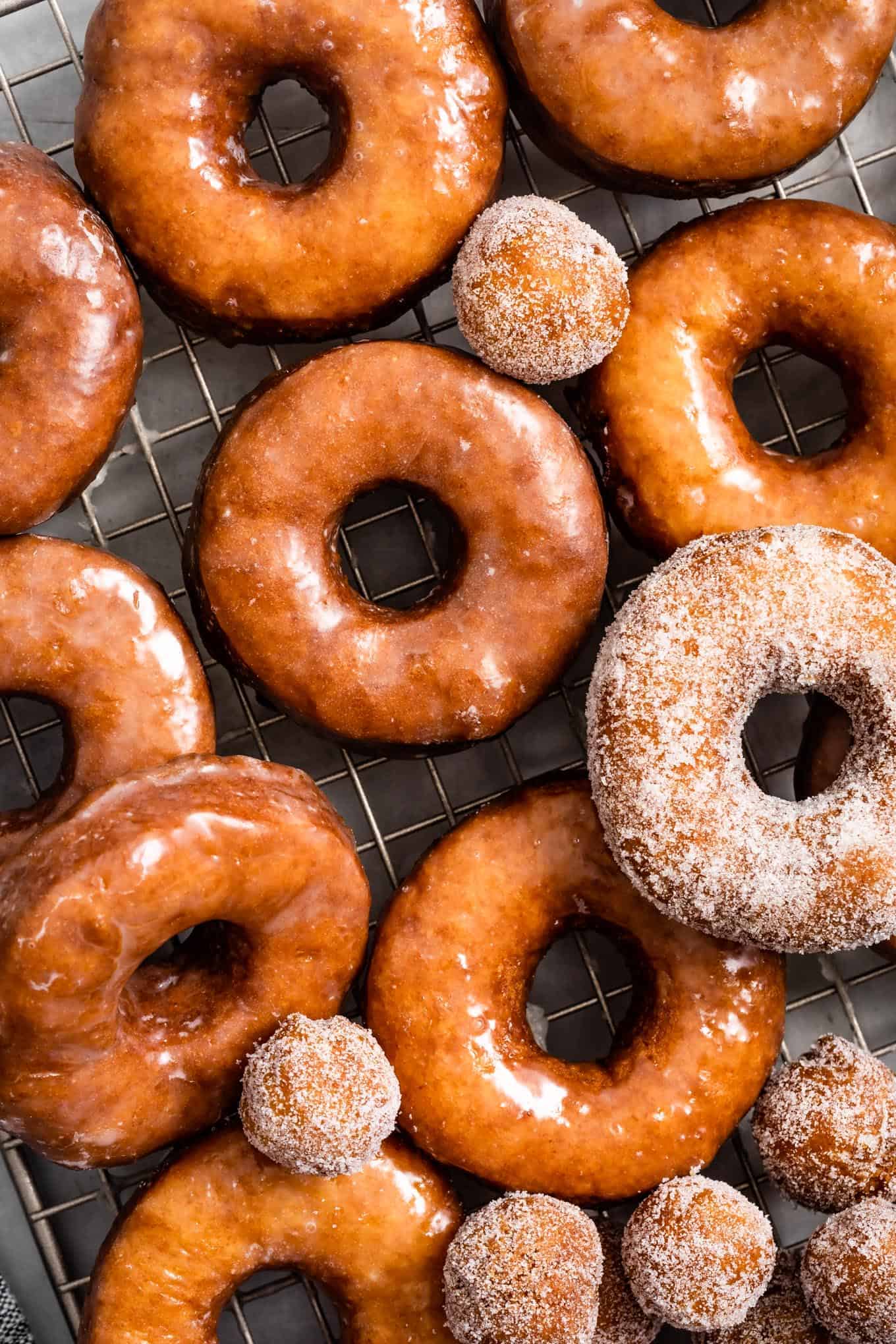


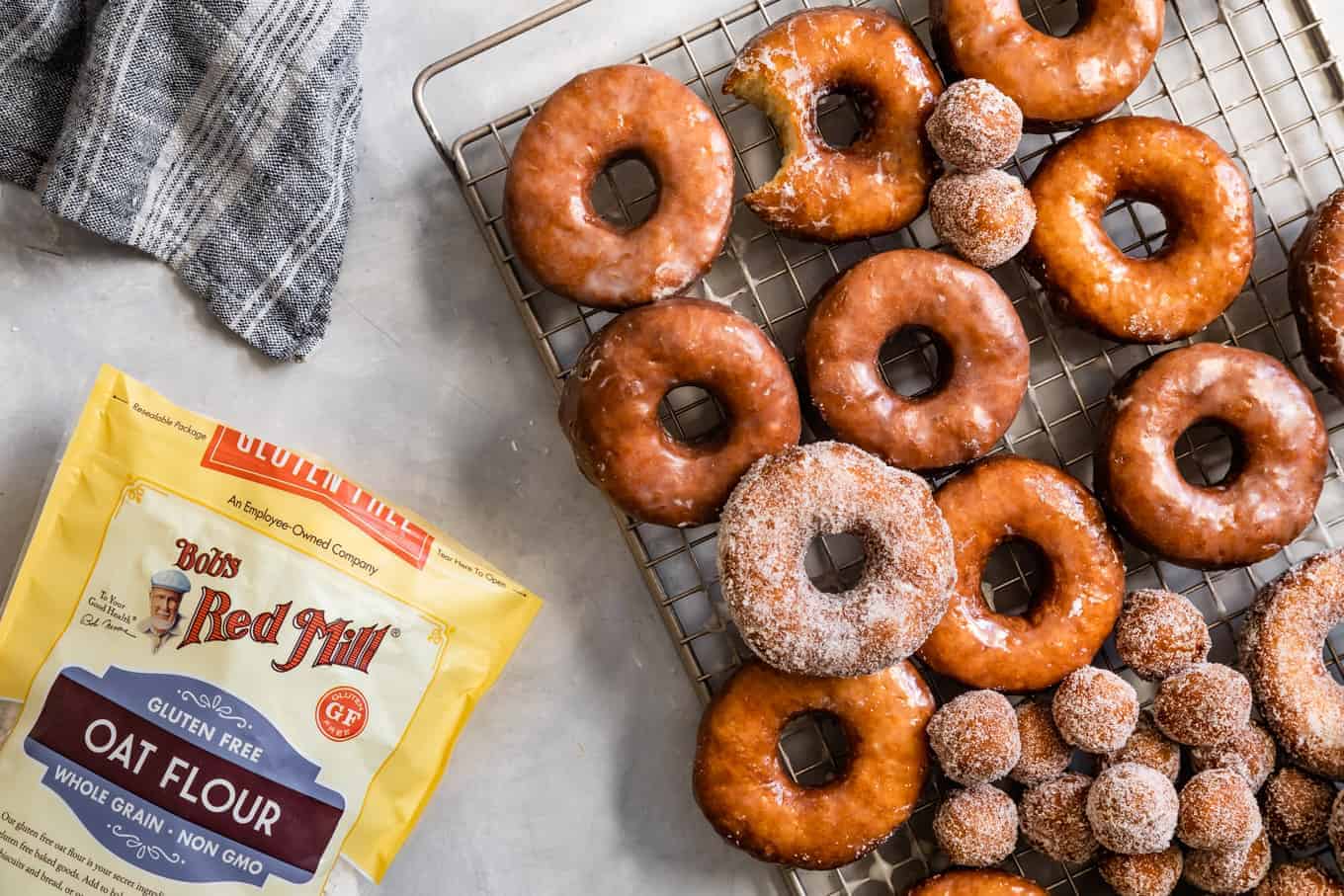
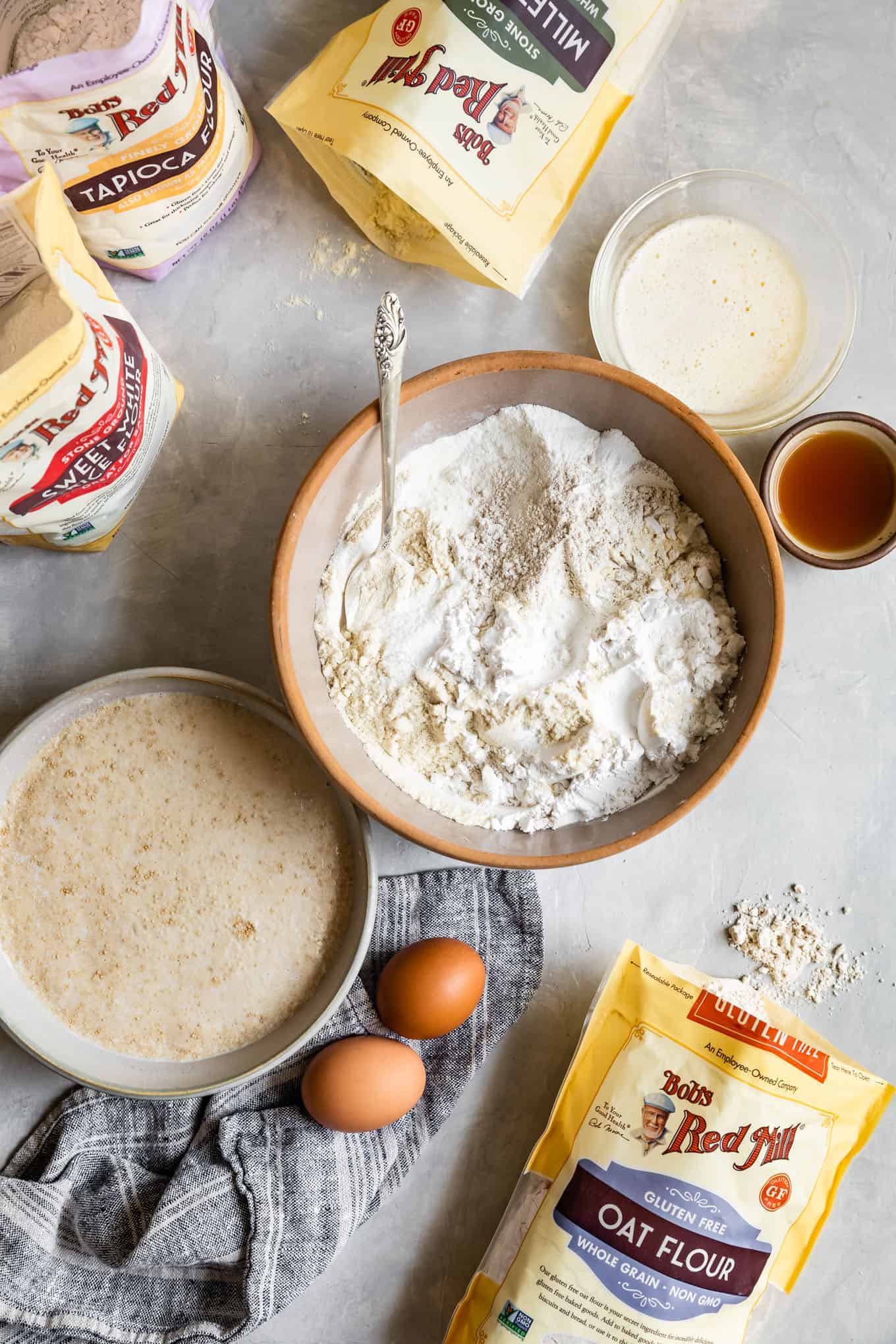




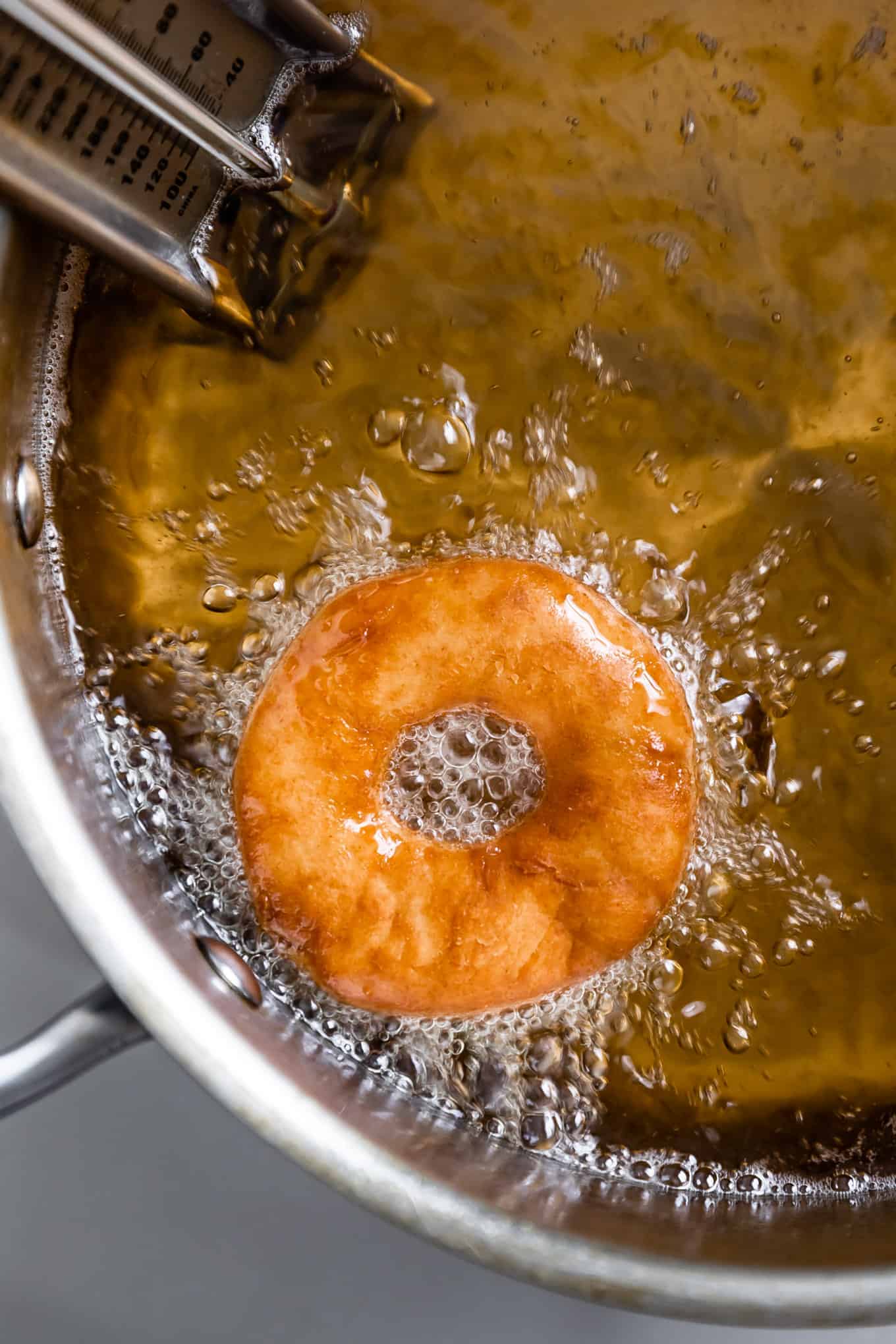

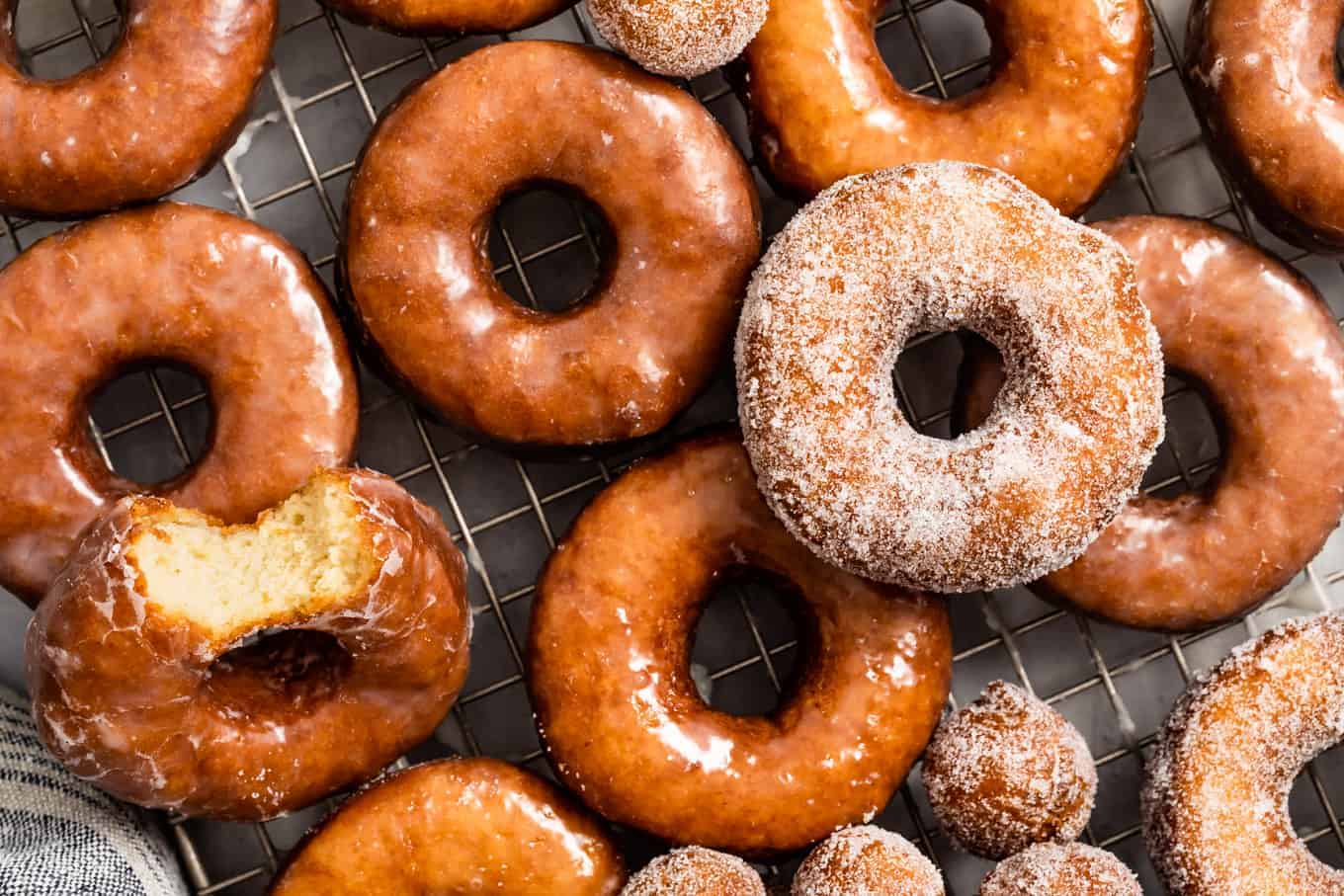

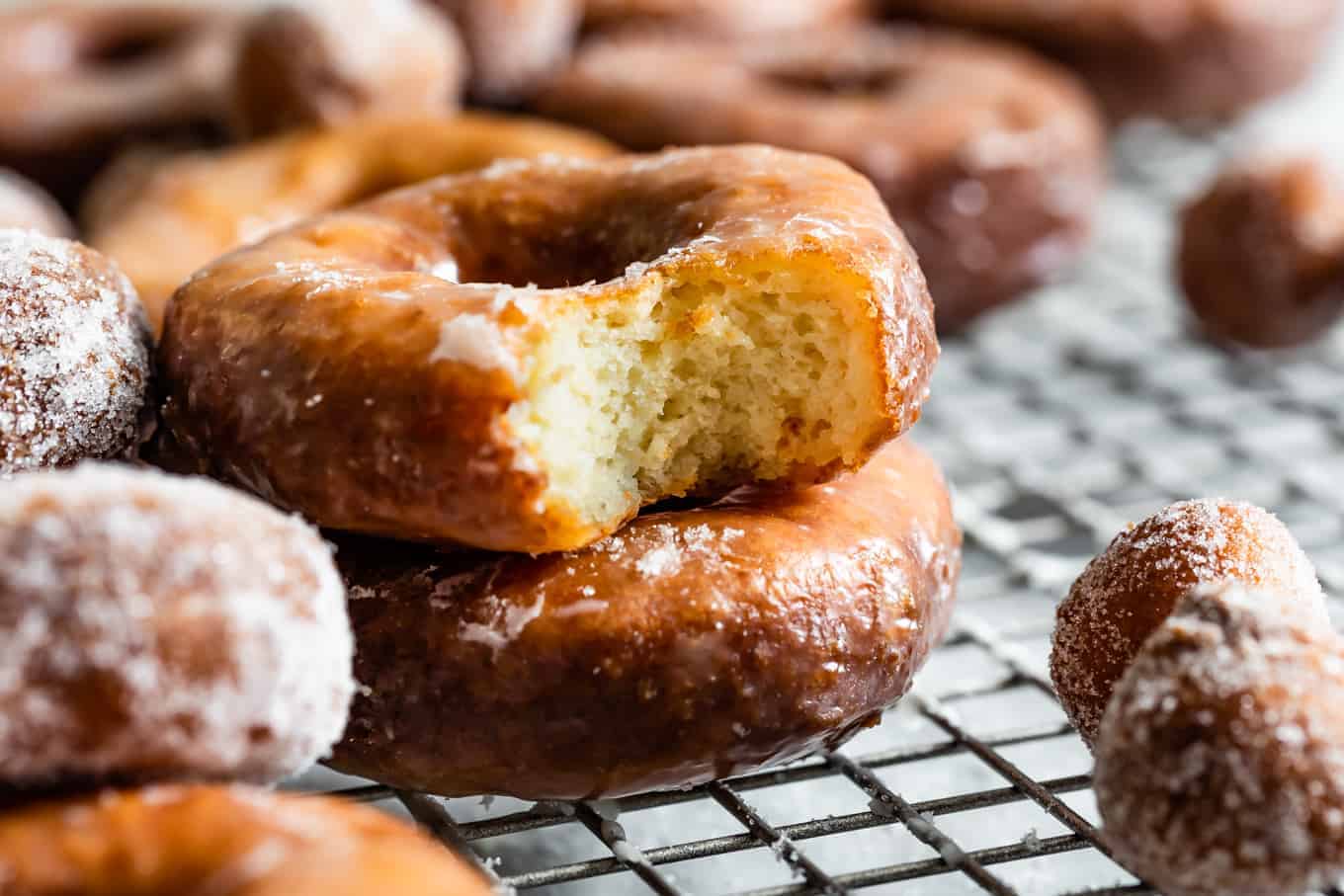





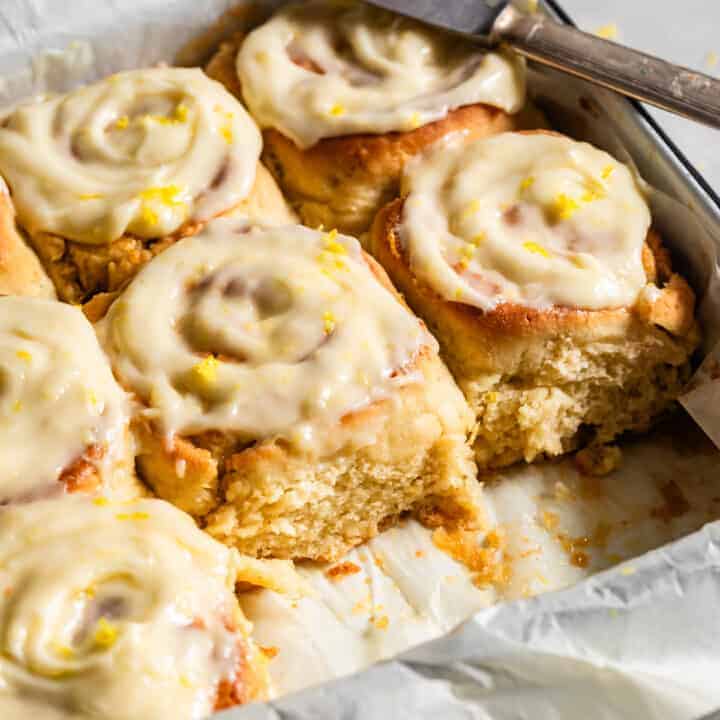

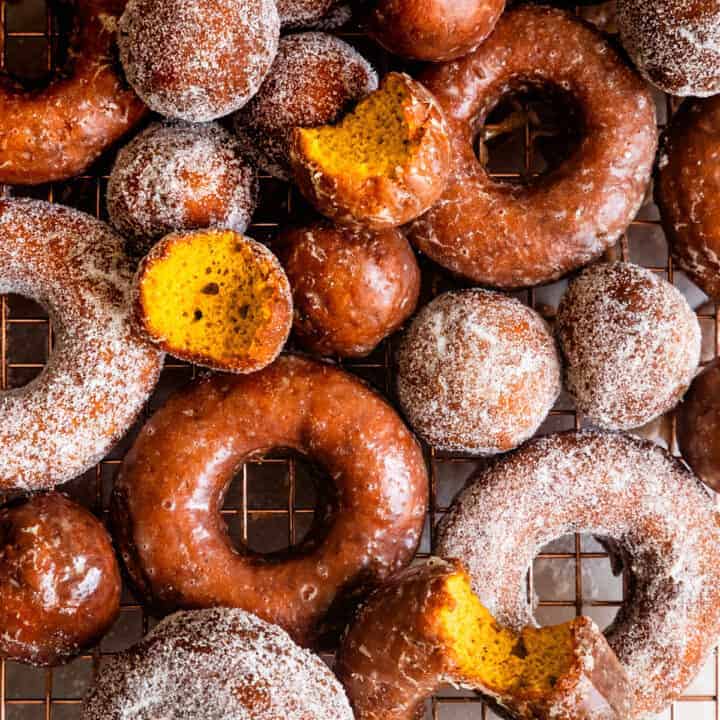
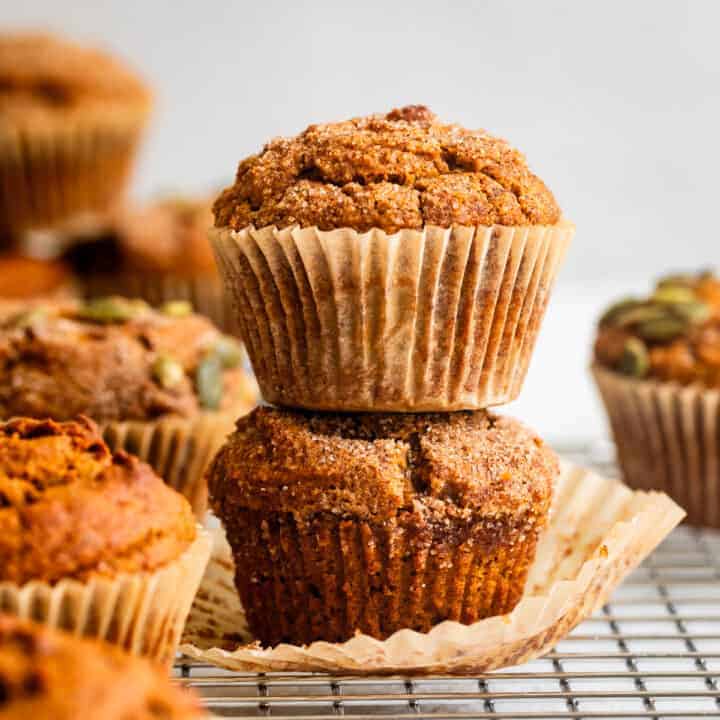
Jennifer -
I'm not actually gluten-free myself, but I've really enjoyed baking gf since becoming friends with someone who can't eat gluten. All the different flour variations are so tasty and creative. These donuts are great and I can't wait for the pumpkin version!
Holly -
Hi Sarah. Just a question about Step 4...when you say "Gently form the dough into a ball with the surface dusted with tapioca flour so it is no longer sticky." I assume you mean until the surface of the ball is no longer sticky? Or do you mean knead it with the tapioca until the entire dough mass is not sticky? I had a particularly tricky time with this step cuz my dough was super sticky.
Sarah Menanix -
Thanks for the clarifying question! Yes, the dough will be very sticky. You want to make sure your hands and the ball are entirely covered with a thin layer of tapioca flour. This will make the surface of the dough no longer sticky. I've created an IG story highlight video to show this process - let me know if this helps clarify!
Christina O -
Fried these up this morning and they were perfection. I fried them at 340 degrees as it was getting too dark too fast at 360. I did the oat flour version. It has the taste and texture of an old fashioned glazed donut. Not gummy at all, like most gf donuts I’ve tried. My husband who hasn’t had a good donut in a year since going gluten free, fell in love with me all over again, lol!! I’m gonna try making this recipe as an apple fritter donut next since it feels like the perfect batter for that! Great job developing this recipe Sarah! It’s a gift to our family.
Lulu -
What attachment do you use when mixing the dough?
Sarah Menanix -
Use the stand mixer fitted with the paddle attachment
Anna -
Hello, I have a question. This recipe looks great, wondering if I have to fry it in so much oil. Can't i do couple inches in a pan and fry it like that? I don't want to waste so much oil...
Sue Bartolotta -
I made these for my daughter, who eat gluten free because of stomach problems and my daughter-in-law who has celiac. They both LOVED them! They were so very excited when I brought them to our Mother's Day celebration. Thanks for an awesome recipe!!
Cathy-ann -
Hi Sarah,
Could I just shape them into donuts and allow to rise and then fry instead of letting the dough rise shaping donuts and letting them rise again?
Sarah Menanix -
This is what I do when I let them do a slow fridge rise overnight. However, what I've noticed when I shape them before the first rise, is that the dough tends to split a bit on top as it rises, making them not quite as pretty. They still taste delicious though!
TXMom -
Will this work with something else besides oat flour? We have oat sensitivities.
Sarah @ Snixy Kitchen -
There’s an almond flour variation that doesn’t use oat flour - that should work for you!
Michelle Siriani -
Can you make them vegan? Can I substitute the eggs?
Gillian Wenger -
Can I make cream filled donuts out of this? Oh how I miss a cream filled donut!
Jonathan -
Can I substitute the butter for vegetable oil?
Monika Lamantia -
I noticed for all of the flours used it states you can sub it with bobs red mill 1 to 1. Does that mean I can make the donut with just that one flour and it will turn out okay?
Sarah Menanix -
Great question! I would recommend only subbing 1-2 of the flours for the best results. You could sub all the flours with Bob's 1-to-1, but your results won't be quite as fluffy.